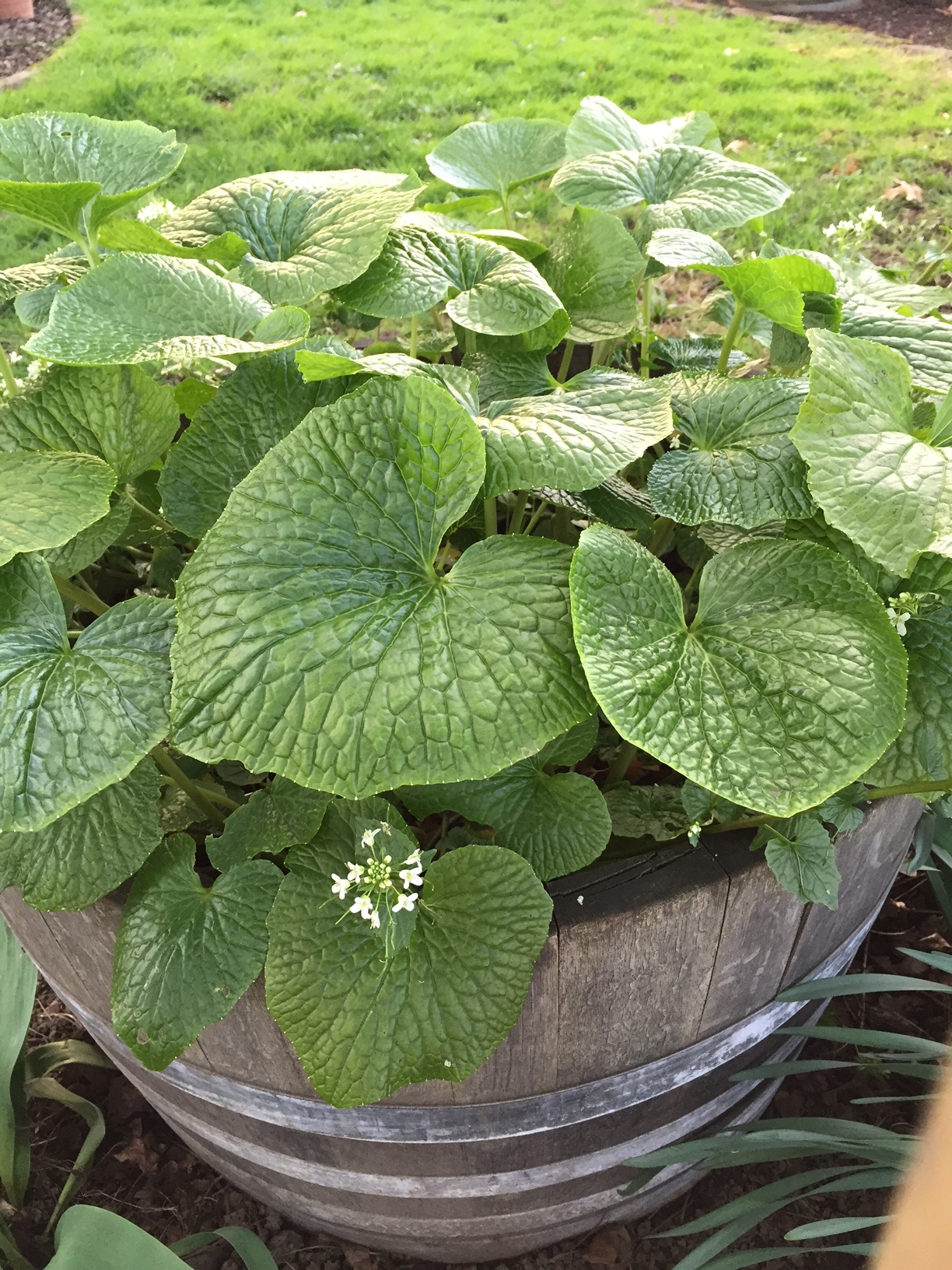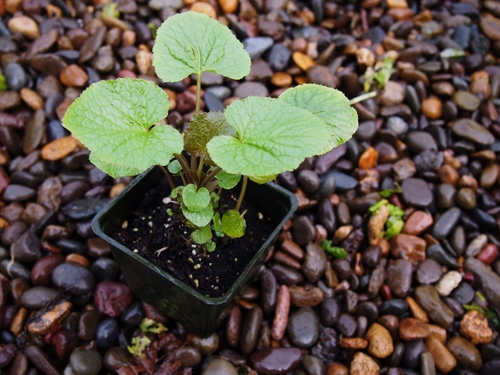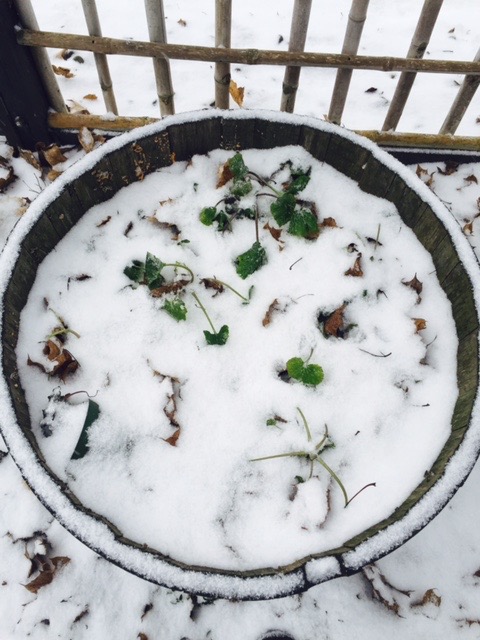We sell PLANT starts for your garden.
Have a shady spot in your garden? Want year-round greens to eat straight from your garden? Then plant wasabi! Wasabi can grow in everybody's garden. Our blog contains many anecdotes and photos of wasabi in the garden and growing overwinter no less! Plant starts can be planted year-round and should grow continuously (.e.g an autumn-planted start can grow through the winter). In fact, we prefer Autumn and early late Winter/early Spring planting. As these plants grow year-round and are light-phobic they should establish quite well off-season. Please see our blog for updates and more information (and make sure to sign up for new blog posts). Please see the blog post titled: "Customer Appreciation Day" to see customer plant growing examples.
If you plant in the summer and the plants are slow to take, keep watering. They need temps below 80dF to thrive. If temps are over 80dF, the plants will simply stop growing and wait for more appropriate conditions. Keep watering and wait for Autumn. See the blog for guidance.
The leaves, stems and flowers of garden-grown wasabi plants are perfectly edible. Wasabi is a brassica. So, like kale, the leaves and stems on the side can be removed / snipped off and eaten while the plant will grow from the top (apical meristem). The examples shown on this page were grown in the Willamette Valley in Oregon (Plant Hardiness Zone 8a.), not on the Oregon Coast where the Frog Eyes Wasabi Farm is located. We wanted to approximate a laissez faire gardener environment, with no special treatment, hot and dry conditions in the summer and cold in the winter (relative to the Oregon Coast) to test the plants' response. They were planted in September, 2014 and the foliage shown is in March 2015. They were grown in well-drained soil with approximately 30% gravel and the remainder soil and compost. A bit of 14-14-14 lawn fertilizer was applied once per year. They endured an ice storm in November 2014 and snow in December 2015.
We sell wasabi plant starts (synonym: seedling). These starts are the very same starts that wasabi growers use to propagate commercial wasabi. From even the smallest plant start, a wasabi plant can grow. As long as there is an apical maristem, the plant can grow. The plant starts does not need to have roots, stems or leaves to grow into a full plant.
The plant starts are shipped with the stems and leaves trimmed away as bare root because the plants are healthier and shipping costs are decreased. The plants are quite adept at transplanting and regrowing leaves and stems. In fact, we trim the leaves and stems off all our commercially-planted plantlets for the same reason we trim them for our customers: the heavy and long stems and leaves can pull the plant over on its side before its roots are established. The plant will still send out roots, but it will grow faster when upright. See photos on this page for examples of a trimmed offshoot.
Plant starts are sold bare root. Shipping and associated shock are not a problem. The plant starts can be perfectly healthy out of the ground for months (although we ship to order and they are shipped freshly-harvested). There is no need to ship them with heavy pot and soil which is expensive to ship and totally unnecessary. The plant uses the rhizome as food / nutrient storage and the roots and stems will grow from the rhizome.
We currently sell only daruma variety plant starts.






Planting conditions:
Generally, wasabi plants prefer exceptionally low-light conditions, high water volumes in exceptionally well-drained soil. (Plant in full shade year round - this can't be stressed enough.) Additionally, if (when) the ambient air temperature surpasses 80dF, the plants will stop growing and likely wilt (particularly if not watered daily). If this occurs, do not compost the plants; they are only waiting for the temperatures to drop again. Keep watering; maintain hope, they should regrow once the temperatures drop again in the Autumn. Keep watering.
Full Shade - all year. Truly. Even in February sun, the leaves will wilt. Full shade. All year. Leaves will brown into a bronze color if they are getting too much sun. If so, transplant. These plants transplant very well.
In the summer, water every day. Even just a bit (1 minute from a hose nozzle). If a day is missed it's OK. Really. The stems may droop a bit and the leaves may wilt. Water the next day and they'll straighten out again overnight.
Nutrients: Use any NPK nutrients you have readily available or a straight 14. The plants suffer very little or no transplant shock. We have plants that have been existing under our blackberry bushes in the hedgerows for years with no nurturing whatsoever; they flower and grow just fine and look much like the potted plant on this page.
Also note that the plant will only grow a rhizome if it is in perfect conditions. If in imperfect conditions, the offshoot should still produce petioles and leaves and flower in the spring. The petioles and leaves are edible - as are the flowers.
We have other anecdotes, photos and growing examples on our blog. (And please sign up for blog post alerts. We do update regularly, but not we promise, we have lots more to do than flood your inbox; a farmer's work and all.)
Learn more about growing wasabi here: Growing Wasabi in the Pacific Northwest Carol Miles and Catherine Chadwick A Pacific Northwest Extension Publication Washington State University • Oregon State University • University of Idaho
Link to digital version of plant start growing information we send in all plant start packages.
